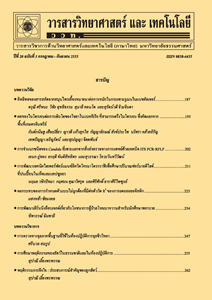สมบัติทางรีโอโลยีและคุณภาพทางประสาทสัมผัสของถั่วเขียว (Vigna radiate L.) กวน
Main Article Content
Abstract
บทคัดย่อ
งานวิจัยนี้มีวัตถุประสงค์เพื่อศึกษาสมบัติทางรีโอโลยีและการยอมรับทางประสาทสัมผัสของถั่วเขียวกวน โดยแปรอัตราส่วนของปริมาณถั่วเขียว น้ำตาลทราย และกะทิ ตามการจัดสิ่งทดลองแบบ mixture design ช่วงการศึกษาปัจจัยประกอบด้วยถั่วเขียว (X1) ร้อยละ 24-33 น้ำตาลทราย (X2) ร้อยละ 24-40 กะทิ (X3) ร้อยละ 33-48 จากการศึกษาสมบัติทางรีโอโลยีของถั่วกวนด้วยวิธี lubricated squeezing flow พบว่าค่าสัมประสิทธิ์ความหนืด (KB) ของถั่วเขียวกวนมีแนวโน้มสูงขึ้นเมื่อปริมาณถั่วเขียวและกะทิลดลง ส่วนปริมาณน้ำตาลทรายเพิ่มขึ้น เมื่อพิจารณาค่าดรรชนีการไหล (n) ของถั่วเขียวกวน พบว่าถั่วเขียวกวนทุกอัตราส่วนมีพฤติกรรมการไหลแบบ extensional thinning fluid โดยค่า n มีแนวโน้มสูงขึ้นเมื่อปริมาณน้ำตาลทรายและกะทิเพิ่มขึ้น ส่วนปริมาณถั่วเขียวลดลง เมื่อวิเคราะห์ความแปรปรวนของข้อมูลด้วยและสร้างสมการถดถอย พบว่าสมการ quadratic model อธิบายความสัมพันธ์ระหว่างค่า KB กับส่วนผสมของถั่วเขียวกวนได้ดีที่สุด และสมการ linear model อธิบายความสัมพันธ์ระหว่างค่า n กับส่วนผสมของถั่วเขียวกวนได้ดีที่สุด การศึกษาอิทธิพลของส่วนผสมต่อค่าสีถั่วเขียวกวนพบว่าปริมาณกะทิที่เพิ่มขึ้นมีผลทำให้ค่าความเป็นสีแดง (a*) ของถั่วเขียวกวนลดลง และปริมาณน้ำตาลทรายที่เพิ่มขึ้น มีผลทำให้ค่าความเป็นสีเหลืองของถั่วเขียวกวนเพิ่มขึ้น การทดสอบทางประสาทสัมผัสพบว่าสูตรที่ได้รับคะแนนความชอบทางประสาทสัมผัสมากที่สุด คือ อัตราส่วนของถั่วเขียว น้ำตาลทราย และกะทิ เท่ากับ 33.00 : 34.00 : 33.00 โดยน้ำหนัก
คำสำคัญ : รีโอโลยี; ถั่วกวน; ถั่วเขียว; ดรรชนีการไหล; สัมประสิทธิ์ความหนืด
Abstract
The objective of this research was to study the rheological properties and sensory qualities of mung bean paste by varying the ratio of mung bean, sugar and coconut milk using Mixture design. The ranges of three components were 24-33 % mung bean (X1), 24-40 % sugar (X2) and 33-48 % coconut milk (X3). The rheological properties of bean paste using lubricated squeezing flow method showed that the biaxial consistency coefficient (KB) increased with increasing mung bean and coconut milk ratio but decreasing sugar ratio. The flow behavior index (n) of mung bean paste showed extensional thinning fluid behavior for all of the formulas. The n value increased with increasing sugar and coconut milk ratios but decreasing mung bean ratio. From the analysis of variance (ANOVA) and the regression model, the relationship between KB value, n value with the 3 components of bean paste was found to be the best described by quadratic model and linear model, respectively. The effect of bean paste component on the bean paste color was investigated and found that the increasing in coconut milk caused the decreasing in redness (a*) and the increasing in sugar ratio caused the increasing in yellowness (b*) of the mung bean paste. The sensory acceptance test results indicated that the most accepted bean paste formula was the ratio of mung bean : sugar : coconut milk equaled to 33.00 : 34.00 : 33.00 by weight.
Keywords: rheology; bean paste; mung bean; flow behavior index; consistency coefficient


